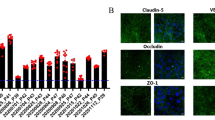Abstract
The nature of blood–brain barrier permeation of most herbal medicines is unknown. To screen blood–brain barrier drug candidates from natural product library, an ECV304/C6 coculture model was established. The permeability parameters and morphological analysis showed that the cultured ECV304 cell monolayer was of integrity and vitality. A library of widely used medicinal plant rhubarb extract was screened using ECV304/C6 coculture model, and then separated and elucidated with liquid chromatography–mass spectroscopy analytical technique. There were three peaks present in the chromatography obtained from the sample of drug candidates that permeated over ECV304 cell monolayer, in which rhein, emodin, and physcion were deduced and identified. Quantitative structure activity relationship analysis showed that the identified three compounds were consistent with the “rule of 5” for drug-like molecules. This result demonstrated that the combination of ECV304/C6 coculture model with chromatography–mass spectroscopy analysis should be an attractive and great potential method for blood–brain barrier drug candidates screening from rhubarb extracts.






Similar content being viewed by others
References
Agu RU, Jorissen M, Willems T, Augustijns P, Kinget R, Verbeke N (2001) In-vitro nasal drug delivery studies: comparison of derivatised, fibrillar and polymerised collagen matrix-based human nasal primary culture systems for nasal drug delivery studies. J Pharm Pharmacol 53:1447–1456
Anderberg EK, Lindmark T, Artursson P (1993) Sodium caprate elicits dilatations in human intestinal tight junctions and enhances drug absorption by the paracellular route. Pharm Res 10:857–864
Annette B, Sibylle H, Kayoshi S, Barbara RR, Maja G, Stefanie DK, Heidi WA (2000) Cell cultures as tools in biopharmacy. Eur J Pharm Sci 11:S51–S60
Cordell GA (2000) Biodiversity and drug discovery—a symbiotic relationship. Phytochemistry 55:463–480
Dolman DEM, Anderson P, Rollinson C, Abbott NJ (1998) Characterisation of a new in vitro model of the blood–brain barrier (BBB). J Physiol 505:56–57
Easton AS, Abbott NJ (2002) Bradykinin increases permeability by calcium and 5-lipoxygenase in the ECV304/C6 cell culture model of the blood-brain barrier. Brain Res 953:157–169
Farnsworth, NR (1988) Screening plants for new medicines. In: Biodiversity (Wilson, E.O., Ed). National Academy Press: Washington, DC, pp 83-97
Frank RG (2003) New estimates of drug development costs. J Health Econ 22:325–330
Gentry AH (1993) Tropical forest biodiversity and the potential for new medicinal plants. ACS Symp Ser 534:13–20
Ghose AK, Viswanadhan VN, Wendoloski JJ (1999) A knowledge-based approach in designing combinatorial or medicinal chemistry libraries for drug discovery.1. A qualitative and quantitative characterization of known drug databases. J Comb Chem 1:55–68
Gribbon P, Sewing (2003) Fluorescence readouts in HTS: no gain without pain?. Drug Discov Today 8:1035–1043
Hidalgo IJ, Raub TJ, Borchardt RT (1989) Characterization of the human colon carcinoma cell line (CaCo-2) as a model system for intestinal epithelial permeability. Gastroenterology 96:736–749
Hurst RD, Fritz IB (1996) Nitric oxide-induced perturbations in a cell culture model of the blood-brain barrier. J Cell Physiol 167:81–88
Kuchler-Bopp S, Delaunoy JP, Artault JC, Zaepfel M, Dietrich JB (1999) Astrocytes induce several blood–brain barrier properties in non-neural endothelial cells. Neuroreport 10:1347–1353
Lipinski CA, Lombardo F, Dominy BW, Feeney PJ (1997) Experimental and computational approaches to estimate solubility and permeability in drug discovery and development settings. Adv Drug Deliver Rev 23:3–25
Lu L, Li HQ, Fu DL, Zheng GQ, Fan JP (2014) Rhubarb root and rhizome-based Chinese herbal prescriptions for acute ischemic stroke: a systematic review and meta-analysis. Complement Ther Med 22(6):1060–1070
Mahar Doan KM, Humphreys JE, Webster LO, Wring SA, Shampine LJ, Serabjit-Singh CJ, Adkison KK, Polli JW (2002) Passive permeability and P-glycoprotein-mediated efflux differentiate central nervous system (CNS) and non-cns marketed drugs. J Pharmacol Exp Ther 303:1029–1037
Mendelson R, Balick M (1995) The value of undiscovered pharmaceuticals in tropical forests. J Econ Bot 49:223–228
Newman DJ, Cragg GM, Snader KM (2000) The influence of natural products upon drug discovery. Nat Prod Rep 17:215–234
Pan CJ, Wang J, Huang N (2010) Preparation, characterization and in vitro anticoagulation of emodin-eluting controlled biodegradable stent coatings. Colloids Surf B 77:155–160
Schwab D, Fischer H, Tabatabaei A, Poli S, Huwyler J (2003) Comparison of in vitro P-glycoprotein screening assays: recommendations for their use in drug discovery. J Med Chem 46:1716–1725
Takahashi K, Sawasaki Y, Hata JI, Mukai K, Goto T (1990) Spontaneous transformation and immortalization of human endothelial cells. In Vitro Cell Dev Biol 25:265–274
Viswanadhan VN, Ghose AK, Revankar GR, Robins RK (1989) Atomic physicochemical parameters for three dimensional structure directed quantitative structure-activity relationships. 4. Additional parameters for hydrophobic and dispersive interactions and their application for an automated superposition of certain naturally occurring nucleoside antibiotics. J Chem Inf Comput Sci 29:163–172
Wu B, Liu M, Liu H, Li W, Tan S, Zhang S, Fang Y (2007) Meta-analysis of traditional Chinese patent medicine for ischemic stroke. Stroke 38(6):1973–1979
Yao GY, Ye MY, Huang RZ, Li YJ, Pan YM, Xu Q, Liao ZX, Wang HS (2014) Synthesis and antitumor activities of novel rhein α-aminophosphonates conjugates. Bioorg Med Chem Lett 24:501–507
Youdim KA, Qaiser MZ, Begley DJ, Rice-evans CA, Abbott NJ (2004) Flavonoid permeability across an in situ model of the blood-brain barrier. Free Radic Biol Med 36:592–604
Zhao YL, Wang JB, Zhou GD, Shan LM, Xiao XH (2009) Investigations of free anthraquinones from rhubarb against α-naphthylisothiocyanate-induced cholestatic liver injury in rats. Basic Clin Pharmacol Toxicol 104(6):463–469
Acknowledgments
The authors thank the National Nature Science fund of China for financial support (U1404307, 31401672).
Author information
Authors and Affiliations
Corresponding author
Ethics declarations
Conflict of interest
The authors declare that they have no conflict of interest.
Rights and permissions
About this article
Cite this article
Yuan, JF., Ji, HH., Qiu, ZJ. et al. ECV304/C6 coculture model of the BBB coupled with LC–MS analysis for drug screening from Rhubarb extract. Med Chem Res 25, 1935–1944 (2016). https://doi.org/10.1007/s00044-016-1618-7
Received:
Accepted:
Published:
Issue Date:
DOI: https://doi.org/10.1007/s00044-016-1618-7




